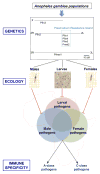Anopheles gambiae pathogen susceptibility: the intersection of genetics, immunity and ecology
- PMID: 22538050
- PMCID: PMC3404259
- DOI: 10.1016/j.mib.2012.04.001
Anopheles gambiae pathogen susceptibility: the intersection of genetics, immunity and ecology
Abstract
Mosquitoes are the major arthropod vectors of human diseases such as malaria and viral encephalitis. However, each mosquito species does not transmit every pathogen, owing to reasons that include specific evolutionary histories, mosquito immune system structure, and ecology. Even a competent vector species for a pathogen displays a wide range of variation between individuals for pathogen susceptibility, and therefore efficiency of disease transmission. Understanding the molecular and genetic mechanisms that determine heterogeneities in transmission efficiency within a vector species could help elaborate new vector control strategies. This review discusses mechanisms of host-defense in Anopheles gambiae, and sources of genetic and ecological variation in the operation of these protective factors. Comparison is made between functional studies using Plasmodium or fungus, and we call attention to the limitations of generalizing gene phenotypes from experiments done in a single genetically simple colony.
Copyright © 2012 Elsevier Ltd. All rights reserved.
Figures

References
-
- Niare O, Markianos K, Volz J, Oduol F, Toure A, Bagayoko M, Sangare D, Traore SF, Wang R, Blass C, et al. Genetic loci affecting resistance to human malaria parasites in a West African mosquito vector population. Science. 2002;298:213–216. - PubMed
-
- Riehle MM, Markianos K, Niare O, Xu J, Li J, Toure AM, Podiougou B, Oduol F, Diawara S, Diallo M, et al. Natural malaria infection in Anopheles gambiae is regulated by a single genomic control region. Science. 2006;312:577–579. The only genetic survey to date of wild A. gambiae for QTLs controlling P. falciparum infection. - PubMed
Publication types
MeSH terms
Grants and funding
LinkOut - more resources
Full Text Sources
Miscellaneous

